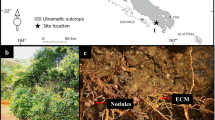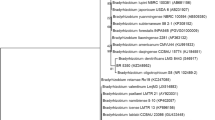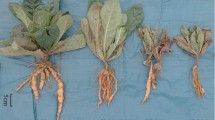Abstract
Bacterial growth in the rhizosphere and resulting changes in plant growth parameters were studied in small aseptic seedlings of birch (Betula pendula and B. pubescens) and grasses (Poa pratensis and Festuca rubra). The seedlings were inoculated with three Frankia strains (Ai1a and Ag5b isolated from native Alnus root nodules and Ai17 from a root nodule induced by soil originating from a Betula pendula stand), and three associative N2-fixing bacteria (Enterobacter agglomerans, Klebsiella pneumoniae and Pseudomonas sp., isolated from grass roots). Microscopic observations showed that all the Frankia strains were able to colonize and grow on the root surface of the plants tested without addition of an exogenous carbon source. No net growth of the associative N2-fixers was observed in the rhizosphere, although inoculum viable counts were maintained over the experimental period. Changes in both the biomass and morphology of plant seedlings in response to bacterial inoculation were recorded, which were more dependent on the plant species than on the bacterial strain.
Similar content being viewed by others
References
Arveby A S and Huss-Danell K 1988 Presence and dispersal of infective Frankia in peat and meadow soils in Sweden. Biol. Fertil. Soils 6, 39–44.
Badenoch-Jones J, Summons R E, Djordjevic M A, Shine J, Letham D S and Rolfe B G 1982 Mass spectrometric quantification of indole-3-acetic acid in Rhizobium culture supernatants: Relation to root hair curling and nodule initiation. Appl. Environ. Microbiol. 44, 275–280.
Bashan Y, Singh M and Levanony H 1989 Contribution of Azospirillum brasilense Cd to growth of tomato seedlings is not through nitrogen fixation. Can. J. Microbiol. 67, 2429–2434.
Berry A M, Kahn R K S and Booth M C 1989 Identification of indole compounds secreted by Frankia HFPAr13 in defined culture medium. Plant and Soil 118, 205–209.
Bousquet J, Girouard E, Strobeck C, Dancik B C and Lalonde M 1989 Restriction fragment polymorphisms in the rDNA region among seven species of Alnus and Betula papyrifera. Plant and Soil 118, 231–240.
Crozier A, Arruda P, Jasmin J M, Montero A M and Sandberg G 1988 Analysis of indole-3-acetic acid and related indoles in culture medium from Azospirillum lipoferum and Azospirillum brasilense. Appl. Environ. Microbiol. 54, 2833–2837.
DeWeger L A, VanBoxel R, Van derBurg B, Gruters R A, Geels F P, Schippers B and Lugtenberg B 1986. Siderophores and outer membrane proteins of antagonistic, plant-growth-stimulating, root-colonizing Pseudomonas spp. J. Bacteriol. 165, 585–594.
Ernstsen A, Sandberg G, Crozier A and Wheeler C T 1987 Endogenous indoles and the biosynthesis and metabolism of indole-3-acetic acid in cultures of Rhizobium phaseoli. Planta 171, 422–428.
Fallik E, Okon Y, Epstein E, Goldman A and Fischer M 1989 Identification and quantification of IAA and IBA in Azospirillum brasilense-inoculated maize roots. Soil Biol. Biochem. 21, 147–153.
Haahtela K, Kari K and Sundman V 1983 Nitrogenase activity (acetylene reduction) of root-associated, cold-climate Azospirillum, Enterobacter, Klebsiella, and Pseudomonas species during growth on various carbon sources and at various partial pressures of oxygen. Appl. Environ. Microbiol. 45, 563–570.
Haahtela K and Korhonen T K 1985 In vitro adhesion of N2-fixing enteric bacteria to roots of grasses and cereals. Appl. Environ. Microbiol. 49, 1186–1190.
Haahtela K, Laakso T and Korhonen T K 1986 Associative nitrogen fixation by Klebsiella spp.: Adhesion sites and inoculation effects on grass roots. Appl. Environ. Microbiol. 52, 1074–1079.
Haahtela K, Laakso T, Nurmiaho-Lassila E-L and Korhonen T K 1988a Effects of inoculation of Poa pratensis and Triticum aestivum with root-associated, N2-fixing Klebsiella, Enterobacter and Azospirillum. Plant and Soil 106, 239–248.
Haahtela K, Laakso T, Nurmiaho-Lassila E-L, Rönkkö R and Korhonen T K 1988b Interactions between N2-fixing enteric bacteria and grasses. Symbiosis 6, 139–150.
Haahtela K, Rönkkö R, Laakso T, Williams P H and Korhonen T K 1990 Root-associated Enterobacter and Klebsiella in Poa pratensis: Characterization of an iron-scavenging system and a substance stimulating root hair production. Mol. Plant-Microbe Interact. 3, 358–365.
Haahtela K, Wartiovaara T, Sundman V and Skujins J 1981 Root-associated N2 fixation (acetylene reduction) by Enterobacteriaceae and Azospirillum strains in cold-climate spodosols. Appl. Environ. Microbiol. 41, 203–206.
Houwers A and Akkermans A D L 1981 Influence of inoculation on yield of Alnus glutinosa in the Netherlands. Plant and Soil 61, 189–202.
Huss-Danell K 1978 Nitrogenase activity measurements in intact plants of Alnus incana. Physiol. Plant. 43, 372–376.
Huss-Danell K and Frej A-K 1986 Distribution of Frankia in soils from forest and afforestation sites in northern Sweden. Plant and Soil 90, 407–417.
Kloepper J W, Leong J, Teintze T and Schroth M N 1980 Enhanced plant growth by siderophores produced by plant growth promoting rhizobacteria. Nature 286, 885–886.
Korhonen T K, Tarkka E, Ranta H and Haahtela K 1983 Type 3 fimbriae of Klebsiella sp.: Molecular characterization and role in bacterial adhesion to plant roots. J. Bacteriol. 155, 860–865.
Lechevalier M P 1985 Catalog of Frankia strains. The actinomycetes 19, 131–162.
Okon Y, Heytler P G and Hardy R W F 1983 N2 fixation by Azospirillum brasilense and its incorporation to host Setaria italica. Appl. Environ. Microbiol. 46, 694–697.
Paschke M W and Dawson J O 1992 Frankia abundance in soils beneath Betula nigra and other non-actinorhizal woody plants. Acta Oecol. 13, 407–415.
Smith W H 1976 Character and significance of forest tree root exudates. Ecology 57, 324–331.
Smith R L, Schank S C, Milam J R and Baltensperger A A 1984 Responses of Sorghum and Pennisetum species to the N2-fixing bacterium Azospirillum brasilense. Appl. Environ. Microbiol. 41, 342–345.
Smolander A 1990 Frankia populations in soils under different tree species-with special emphasis on soils under Betula pendula. Plant and Soil 121, 1–10.
Smolander A and Sarsa M-L 1990 Frankia strains of soil under Betula pendula: Behaviour in soil and pure culture. Plant and Soil 122, 129–136.
Smolander A and Sundman V 1987 Frankia in acid soils of forests devoid of actinorhizal plants. Physiol. Plant. 70, 297–203.
Smolander A, Nurmiaho-Lassila E-L and Sundman V 1988a Effect of a clay mineral (montmorillonite) on the nodulation of Alnus and on the nitrogenase activity of Frankia in pure culture. Symbiosis 6, 37–52.
Smolander A, Rönkkö R, Nurmiaho-Lassila E-L and Haahtela K 1990 Growth of Frankia in the rhizosphere of Betula pendula, a nonhost tree species. Can. J. Microbiol. 36, 649–656.
Smolander A, vanDijk C and Sundman C 1988b Survival of Frankia strains introduced into soil. Plant and Soil 106, 65–72.
Stevens G A and Berry A M 1988 Cytokinin secretion by Frankia sp. HFPAr13 in defined medium. Plant Physiol. 87, 15–16.
Van Dijk C 1984 Ecological aspects of spore formation in the Frankia-Alnus symbiosis. Ph.D. Thesis. University of Leiden, The Netherlands.
Weber A 1986 Distribution of spore-positive and spore-negative nodules in stands of Alnus glutinosa and Alnus incana in Finland. Plant and Soil 96, 205–213.
Weber A, Smolander A, Nurmiaho-Lassila E-L and Sundman V 1988 Isolation and characterization of Frankia strain from Alnus incana and Alnus glutinosa in Finland. Symbiosis 6, 97–116.
Wheeler C T, Crozier A and Sandberg G 1984 The biosynthesis of indole-3-acetic acid by Frankia. Plant and Soil 78, 99–104.
Author information
Authors and Affiliations
Rights and permissions
About this article
Cite this article
Rönkkö, R., Smolander, A., Nurmiaho-Lassila, E.L. et al. Frankia in the rhizosphere of nonhost plants: A comparison with root-associated N2-fixing Enterobacter, Klebsiella and Pseudomonas . Plant Soil 153, 85–95 (1993). https://doi.org/10.1007/BF00010547
Received:
Accepted:
Issue Date:
DOI: https://doi.org/10.1007/BF00010547




